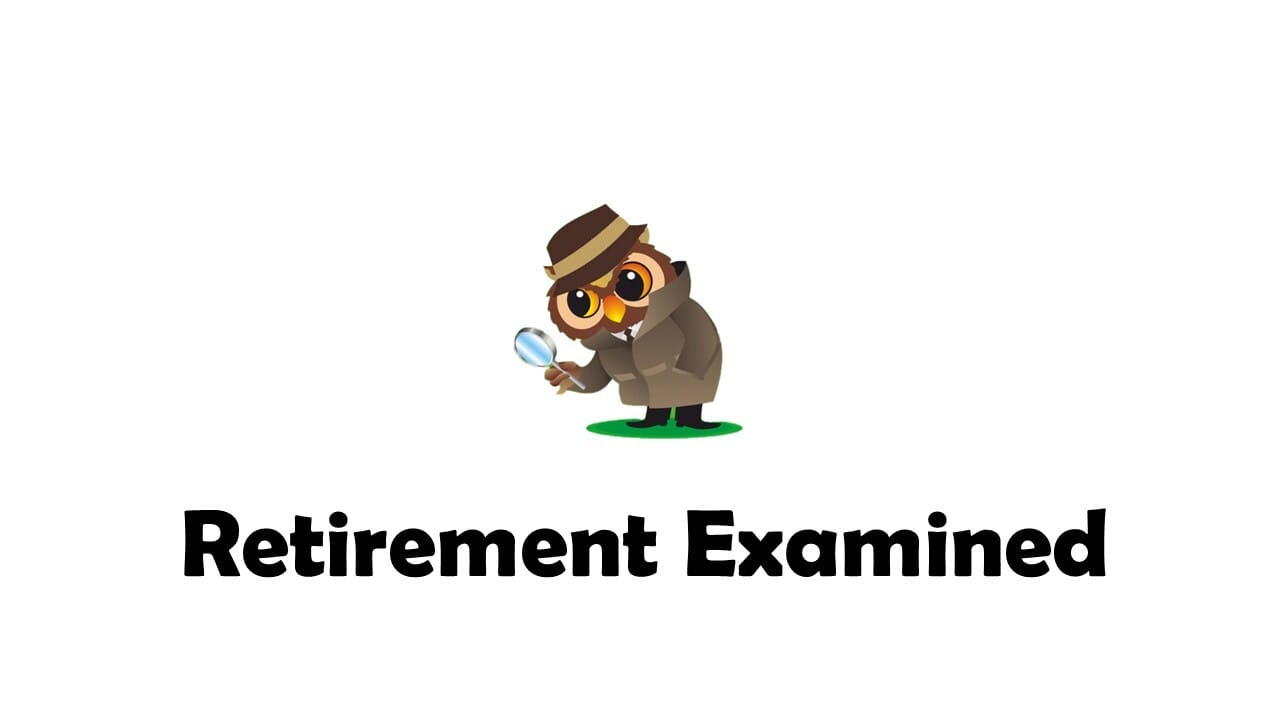- Retirement Examined
- Posts
- Retirement Examined
Retirement Examined
5-Minutes of Breakthrough Secrets: Happy, Fulfilling Retirement

The weekly email that keeps you up to date on exciting Retirement topics in an enjoyable, entertaining way for free.
The Retirement Tax Trap: How the Government is Coming for Your IRA—and How to Stop It
by Eric Seyboldt, MBA

For decades, traditional IRAs have been heralded as the ultimate retirement savings vehicle—a fortress of tax-deferred growth, an inheritance jackpot for heirs, and a simple way to secure a comfortable future. But the rules of the game have changed, and not in your favor.
Recent legislative shifts have transformed IRAs into a tax time bomb, waiting to explode at the worst possible moment—retirement. Those who fail to act now will find themselves at the mercy of an unforgiving tax code, forced to pay a hefty toll just to access their own money. Worse yet, heirs who once stood to benefit from generational wealth will now inherit a financial burden instead.
The good news? There is a way out. But it requires taking immediate action before it’s too late.
THE IRA NIGHTMARE NO ONE WANTS TO TALK ABOUT
Retirees who spent decades building their IRAs expected a smooth transition into their golden years. What they got instead was a bureaucratic labyrinth of distribution rules, hidden penalties, and tax landmines.
Consider this: Under previous rules, heirs could “stretch” withdrawals from an inherited IRA over their lifetime, minimizing tax burdens while allowing the account to continue compounding tax-deferred. That advantage is now gone.
Thanks to the SECURE Act, most beneficiaries must drain inherited IRAs within 10 years—forcing them to take massive, often unexpected distributions that push them into higher tax brackets. What was once a tool for intergenerational wealth transfer has become a financial liability, slashing inheritances and sending retirees scrambling for alternatives.
REALITY CHECK: THE PRICE OF IGNORING THE PROBLEM
Take John, a diligent saver who retired with a $2 million IRA. Under the old rules, his son could have withdrawn the funds over 40 years, keeping tax payments low. Now, under the new law, his son must empty the account within 10 years—pushing him into the highest tax bracket and handing a huge chunk of the inheritance straight to the IRS.
Or consider Susan, a retiree who only withdraws the minimum required from her IRA to avoid unnecessary taxes. She believes she’s playing it safe. What she doesn’t realize is that her balance continues to balloon, setting her up for higher tax rates later when forced minimum distributions skyrocket.
The longer retirees wait, the worse the situation becomes. This isn’t a question of if the government will take a cut—it’s a question of how much.
THE SOLUTION: TAKE CONTROL BEFORE IT'S TOO LATE
There is a way to sidestep the tax trap, but it requires proactive planning. The key? Roth IRA conversions.
Unlike traditional IRAs, Roth IRAs offer:
Tax-free growth—your money compounds without Uncle Sam taking a cut.
Tax-free withdrawals—both for you and your heirs.
No required minimum distributions (RMDs)—ensuring you remain in control of your money.
By strategically converting portions of a traditional IRA into a Roth during years of lower tax rates, retirees can lock in today’s historically low rates rather than gambling on future increases. Yes, taxes are owed on the conversion, but with careful planning, the long-term benefits far outweigh the short-term cost.
ADDITIONAL STRATEGIES TO REDUCE YOUR TAX BURDEN
For those still contributing to retirement accounts, shifting from a traditional 401(k) to a Roth 401(k) eliminates future tax uncertainties. While the upfront tax bill is higher, the long-term payoff is financial freedom in retirement—free from unpredictable tax hikes.
For charitably inclined retirees, Qualified Charitable Distributions (QCDs) allow IRA holders over 70½ to donate up to $105,000 per year directly to charity, reducing taxable income while supporting causes they care about.
Finally, the often-overlooked tax-exempt status of life insurance can be a powerful estate planning tool, providing heirs with tax-free wealth transfer while sidestepping the IRA tax nightmare entirely.
THE TIME TO ACT IS NOW
Retirement should be a time of financial security, not a battle against tax traps. Yet millions of Americans are unknowingly walking straight into a fiscal disaster, unaware that the rules have changed beneath their feet.
This is not a problem that can be ignored. Every year that passes without a plan in place is another year closer to higher taxes, lost wealth, and government-mandated withdrawals.
But there is still time. Those who act now—who take control, restructure their assets, and implement strategic tax-saving moves—will safeguard their retirement, protect their heirs, and ensure their hard-earned wealth remains exactly where it belongs.
Reach out to us for a complimentary, 10-minute consultation call. Let's explore together how we can help you select the right balance of tax diversification, ensuring your golden years are as fulfilling and worry-free as you’ve always imagined. Give us a call today at 614-943-2265 to schedule your consultation. Let's make your retirement dreams a reality!
Smarter Investing Starts with Smarter News
Cut through the hype and get the market insights that matter. The Daily Upside delivers clear, actionable financial analysis trusted by over 1 million investors—free, every morning. Whether you’re buying your first ETF or managing a diversified portfolio, this is the edge your inbox has been missing.

The True Cost of Aging: Will Long-Term Care Wipe Out Your Retirement?
by Eric Seyboldt, MBA
Client: "Eric, I’ve been hearing a lot about long-term care, and frankly, it terrifies me. What are the different types of care available, and how much is this really going to cost me? I want to make sure I don’t end up broke or burdening my kids."
Eric: You are asking the right question—and asking it at the right time. Long-term care isn’t just a vague “what if” scenario; it’s a mathematical certainty for millions of retirees. Nearly 70% of Americans over age 65 will require some form of long-term care. The real question is: will you be financially prepared, or will the system dictate your choices for you?
Let’s break this down.
The Four Levels of Long-Term Care Assistance
In-Home Care – Many people start with in-home care, hiring a home health aide or personal care assistant. This allows retirees to remain in their homes while receiving help with daily activities like bathing, dressing, and medication management.
Cost Today: ~$30/hour, or ~$6,000/month for full-time care.
Cost in 20 Years (assuming 5% inflation): $16,000+ per month.
Assisted Living Facilities (ALFs) – These communities provide housing, meals, and personal care for those who don’t need full-time medical attention but require assistance with daily living.
Cost Today: ~$5,500/month, or ~$66,000/year.
Cost in 20 Years: Projected at over $175,000/year.
Skilled Nursing Facilities (Nursing Homes) – For those who need 24/7 medical supervision, nursing homes offer around-the-clock care. This is one of the most expensive forms of long-term care.
Cost Today: $10,000/month for a private room ($120,000/year).
Cost in 20 Years: Projected at over $350,000/year.
Memory Care Units (Alzheimer’s & Dementia Care) – A specialized form of assisted living or nursing home care designed for those with cognitive decline.
Cost Today: $7,500/month ($90,000/year).
Cost in 20 Years: Easily surpassing $250,000/year.
The Inflationary Nightmare of Long-Term Care
Most people drastically underestimate how inflation compounds over time. Even at a modest 5% inflation rate, the cost of care will more than triple over the next two decades. This isn’t a hypothetical exercise—it’s happening now.
Consider this: If a retiree today needs 5 years in a nursing home, that’s $600,000 at today’s prices. Fast-forward 20 years, and that same care could cost $1.75 million. That’s per person—meaning a married couple could be staring down a $3.5 million expense.
Who Pays for This?
Medicare? No—Medicare only covers short-term skilled nursing after a hospital stay (up to 100 days).
Medicaid? Only if you have spent down nearly all your assets.
Private Insurance? Traditional health insurance doesn’t cover long-term care.
Long-Term Care Insurance? Helpful, but premiums are rising fast. Policies now cost $5,000–$12,000 per year and have limitations.
Out of Pocket? For many, this is the default. And it can devastate a retirement portfolio.
What Can Be Done?
Here’s where proactive planning is non-negotiable. Those who wait until they need care have already lost the financial battle.
Hybrid Long-Term Care Insurance – Modern policies combine life insurance with long-term care benefits, ensuring that if you don’t use the care, your heirs still receive a payout.
Trust Planning – Irrevocable trusts can shield assets from Medicaid spend-down rules.
Strategic Asset Allocation – Certain investments can be structured for liquidity, ensuring funds are available when care is needed.
Annuities with Long-Term Care Riders – These provide lifetime income streams that can double for long-term care expenses.
The Bottom Line
This isn’t about if you’ll need long-term care—it’s about when and how much. The worst mistake retirees make is assuming this problem will “work itself out.” It won’t. Without a solid plan, long-term care costs can dismantle even the best retirement strategy.
The real question is: Do you want to control your future, or do you want the future to control you?
Contact us for a free, brief 10-minute consultation. Together, we can discuss ways to safeguard your wealth and ensure your retirement years are as enjoyable and stress-free as you've envisioned. To arrange a complimentary 10-minute consultation call us today at 614-943-2265. We're here to help turn your retirement aspirations into reality.

Fixed annuities can be an essential component of a well-rounded retirement strategy, offering security, predictability, and efficiency in financial planning.
These are current fixed annuity rates and their durations from Top A-rated Carriers (subject to change at any time, not FDIC insured):
Rates Just Popped Up Again! Don’t Wait To Lock These Fixed Annuity Rates In Today!
3-year: 5.10% (under $100k Deposited)
3-year: 5.25% (over $100k Deposited)
5-year: 5.30% (under $100k Deposited)
5-year: 5.45% (over $100k Deposited)
Please feel free to call Eric at 614-943-2265 if you’d like to ask any questions or request information on these fixed annuities or other retirement topics that are on your mind.

“He who is not contented with what he has, would not be contented with what he would like to have.”

Socrates Teaching
REAL ASSETS, Invest Like the Ultra-Wealthy

Have You Considered Adding ‘Real Assets’ like Gold or Bourbon to Your Investment Portfolio?
Amid the current economic uncertainty, savvy investors are increasingly turning to physical assets as a safeguard for their retirement savings. Tangible options like gold, and even bourbon barrels are gaining traction, offering a reliable shield against the effects of inflation and excessive currency production. These real assets not only provide a strong defense but also add valuable diversification to portfolios, even during stable economic periods.
Historically, physical assets have demonstrated superior performance compared to other investments during times of market turbulence and financial instability. They consistently deliver dependable protection against economic upheavals. Integrating tangible assets into your investment strategy can be both strategic and rewarding.
In light of today’s economic challenges, considering physical assets may be a smart move to bolster the resilience of your financial plans. Are you interested in discovering how these investments could strengthen your portfolio?
Allocating funds into the asset class known as “Real Assets” may be a strategy that you should consider.
Ask us how to Rollover a portion of Your IRA or 401k To A BOURBON IRA (www.bourbon.fund/how-it-works/) or a GOLD IRA (see link below) and:
Safeguard your assets from the collapsing dollar
Incorporate the ‘REAL ASSET’ class into your portfolio like the ultra-wealthy
Hedge against the current high-inflation conditions
Protect your retirement assets against economic crises
Just get in touch. We make it easier than ever.
CONNECT WITH US

Eric Seyboldt, MBA
Feedback or Questions?
You’re invited to get in touch with us if you’d like to find out how the Novus Financial Group can help you on your journey to a happy, fulfilling life in Retirement.
Office: 614-943-2265
Feel Free To Forward Retirement Examined To A Friend and Have Them Subscribe By Clicking The Button Below:
Reach out if you’d like to advertise your business on Retirement Examined or would like to be a sponsor.
Investment advisory services are offered by duly registered individuals on behalf of CreativeOne Wealth, LLC a Registered Investment Adviser.
The content we provide here isn’t financial advice and cannot be taken as such. Please speak to your financial advisor before making any investment decision. Also, note that every investment comes with its risks and drawbacks. Lastly, we would like to remind you that past results cannot guarantee future returns.
This website contains one affiliate link. When you click on the link and make a purchase, we may receive a commission at no additional cost to you. We only promote companies that we have personally used or researched and believe will add value to our readers


